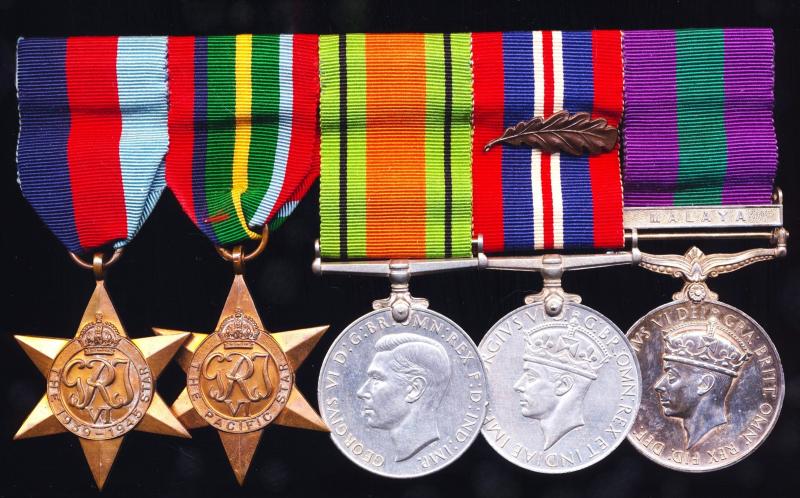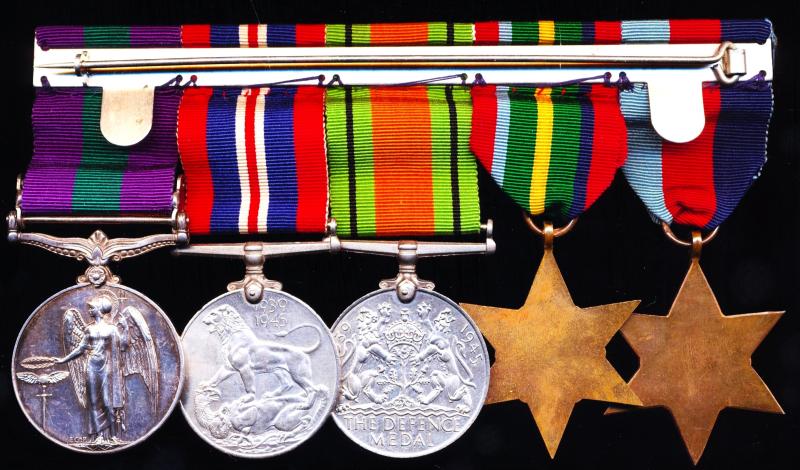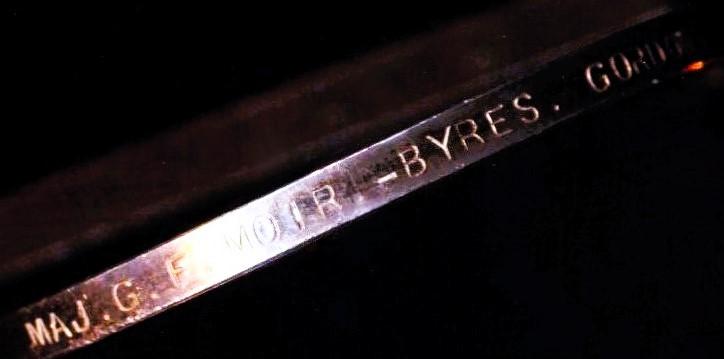An extremely rare Officer's double 'Malaya' campaign medal group to a former 'Wounded-in-Action' later decorated 'Far East Prisoner of War': Major, George Francis Moir-Byres, 1st Battalion Gordon Highlanders late 2nd Battalion Gordon Highlanders
- The 1939-45 Star. No clasp
- The Pacific Star. No clasp
- Defence Medal
- War Medal. With 'Oakleaf' emblem for Mention-in-Despatches (Malaya Campaign 1942)
- GSM 1918. GVI type II clasp 'Malaya' (Maj. G.F. Moir-Byres, Gordons.)
Rarity: It is estimated that less than 29 'All-Ranks' of the Gordon Highlanders, earned and received both a Pacific Star (service in 1941-1942) & later GSM 'Malaya' (service 1948-1953) while serving with the Gordon Highlanders
Wounded-in-Action: Captain is confirmed having been 'Wounded-in-Action' by Japanese dive-bombers in Southern Johore, on, 27 January 1942. During the same air attack, Australian Captain Robert P. A. Rabett, 2/15th Field Regiment was mortally wounded and died shortly thereafter on, 2 February 1942
Decorated for Services as a Far East Prisoner of War: The award of the Mention-in-Despatches was published in the London Gazette issue of. The preamble to the award states:
Quote,
War Office, 10th September, 1946.
The KING has been graciously pleased to approve hat the following be Mentioned in recognition of gallant and distinguished services while Prisoners of War: —
Unquote
The below following is a complete listing of all the Gordon Highlanders decorated with a Mention-in-Despatches for their services as F.E.P.O.W.'s
Capt. G. F. MOIR-BYRES (69179).
Lt. W. DE MIER (129023).
Lt. R. G. FLETCHER (176944).
Lt. J. B. H. LECKIE (211470).
Lt. V. I. D. STEWART (189550) (posthumous).
2867720 Sgt. A. PALLANT.
2876326 Pte. E. STRACHAN.
Far East Prisoner of War: While holding the rank of Temporary Captain, George Francis Moir-Byres, is confirmed having been interred as a Prisoner of War at Singapore on 15 February 1942. Subsequently transported to Thailand for work on the infamous 'Death Railway', Captain Moir-Byres was 'Liberated' from captivity as a F.E.P.O.W. in Thailand on, September 1945
During his incarceration in Thailand 1942-1945, Captain Moir-Byres, 'Liberation Questionnaire' confirms that he served at the below following Japanese P.O.W. Camps
- Chunkai, 1943: Camp Leader, Colonel Williamson
- Camp No 211, 1943: Camp Leader, Colonel Swinton
- Nakon Paton (Nakhon Pathom), 1944: Camp Leader, Colonel Sainter
- Kan Buri (Kanchanaburi), 1945: Camp Leader, Colonel Toosey
In his 'Liberation Questionnaire' Captain Moir-Byres, made special mention of one Gordon Highlander who he wanted to record for 'Courageous Acts Performed By Allied Personnel' during his years of captivity as a F.E.P.O.W.:
Quote,
R.S.M. Milne of the 2nd Bn Gordon Highlanders, though badly wounded in the right-shoulder during the Malayan Campaign and suffering 11 operations as a P.O.W., continued with the major part of the Battalion when marching and living in bad conditions, on the Thai-Burma Railway when he could have stayed in a reasonably good camp. His continual devotion to duty, unselflessness, and the bearing did much to retaining the morale of the men
Unquote.
George Francis Moir-Byres, son of Edward Byres Moir-Byres (a long time British resident Tea Planter in Assam) and Mary Eva Moir-Byres (nee Gibson), was a native of Kensington, London, England, where he was born on, 15 May 1916. 1909. George chose a career as a professional soldier, and was commissioned as an officer prior to the Second World War. He was posted to 2nd Battalion Gordon Highlanders, and served pre-war in Singapore Colony, where the Gordon's had been serving since 1936, as a 'Fortress Singapore' garrison battalion, in 2/Malay Brigade which was a constituent formation of 'Singapore Division'. In Singapore Colony, 2/Gordons were based at Selarang Barracks
Prior to the outbreak of the Pacific War, George had become an accomplished sailor, and formed a close friendship with his fellow brother officer Ivan Lyon - a Scottish scion of the Boyes-Lyon family, and cousin of the Queen (Ivan Lyon 'The Tiger' was later recommended for a Victoria Cross, and awarded the DSO & MBE for his subsequent leadership of the special forces raids launched against Japanese shipping in Singapore and the Singapore Straits, viz Operations Jaywick (1943) & Rimau (1944)
On the surrender of Singapore Colony on 15 February 1942, Captain Moir-Byres was incarcerated as a Far East Prisoner of War. He remained in Singapore until 1943, in which year he was transported to Thailand to work on the infamous 'Death Railway. After surviving the ordeals of internment in South East Asia, after liberation in September 1945, Captain Moir-Byres was repatriated to the United Kingdom, where, after a period of rest and recuperation he returned to his regiment to pursue his career as a British Army Officer. Promoted to Major, he later, from 1950 served with 1st Battalion Gordon Highlanders in Malaya during the 'Emergency'. After retiring from the British Army, Major George Francis Moir-Byres relocated to Australia, where in 1977, he was living at, Nedlands, Curtin, Western Australia. Major Moir-Byres died at Perth, Australia on, 25 July 1997
The medals professionally in the swing style, on their original silk ribands, and as-worn by the recipient. The white metal medal mounting bar retaining its long hinged pin and clasp fittings
Note: The recipients miniature medals, as well as the fathers full-size and miniature medals are listed separately for sale on the website
Condition: About EF
Code: 24332







